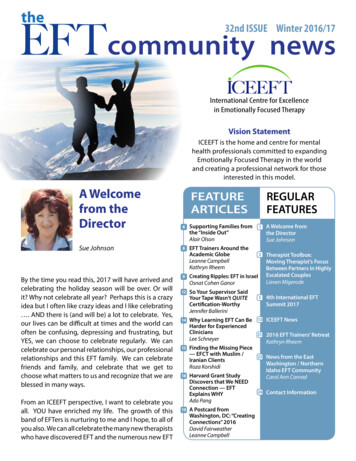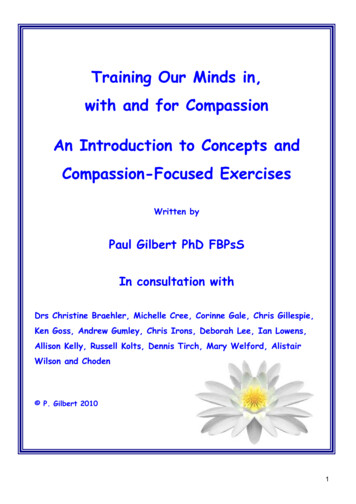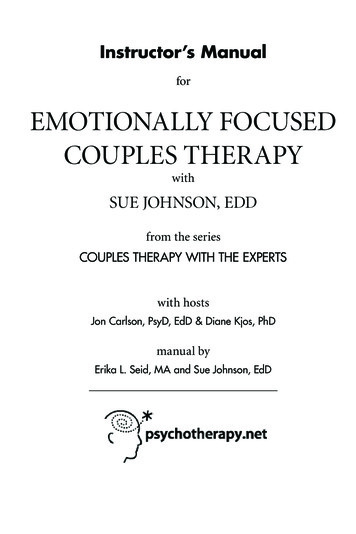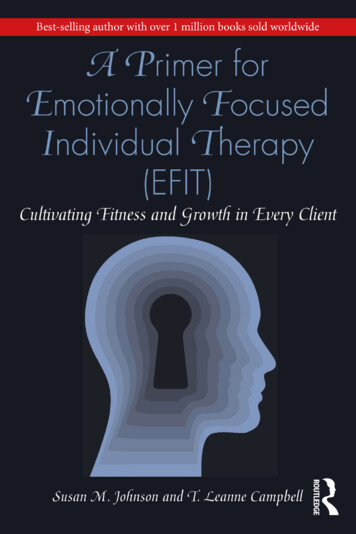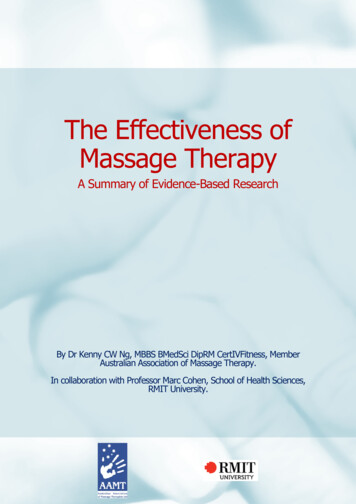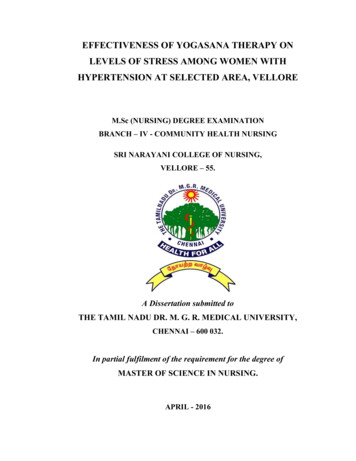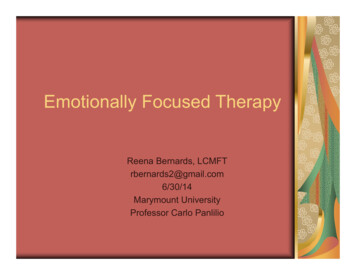
Transcription
Emotionally Focused TherapyReena Bernards, LCMFTrbernards2@gmail.com6/30/14Marymount UniversityProfessor Carlo Panlilio
IntroductionCertified as an EFT therapist byInternational Center for Excellence inEmotionally Focused Therapy (ICEEFT}Background with emotional workCurrently working with couples usingEFT in group practice in Kensington, MDCreative process of applying EFT toindividuals and families
Emotionally Focused TherapyFounded in 1990’s by Dr. SusanJohnson, psychologist from Ottawa,Canada (other original founder LesGreenberg)EFT is an evidence-based couplestherapy, as effective as CBT (or more)Theory and practice can be applied totherapy with families & individuals.
Theoretical Roots1. Family Systems Theory (Minuchen, etc.)Causality is circularTask of therapist is to interrupt negativerelational cycles so that a new pattern canemerge2. Experiential Therapy (Rogers. Pearl)Empathically reflecting and validating aperson’s emotional experienceFoster new corrective emotional experiencesthat emerge from the “here and now.”
Theoretical Roots continuedAttachment Theory (Bowlby, Ainsworth)People need close primary attachments “fromthe cradle to the grave.” (Bowlby)Secure bonds promote a person’s ability toregulate emotions, solve problems, think clearlyand communicate effectively.An adult’s ability to create secure relationships isrelated to the attachment style they learned fromtheir primary relationships as a child.
Attachment StylesBowlby found that from early in childhood, aperson acquires a way of attaching to others:Secure attachmentInsecure, Anxious attachment (pursue, blame)Insecure, Avoidant attachment (withdraw)Insecure, Fearful-Avoidant, (seeks and avoids closeness,associated with trauma history)A person’s attachment style has a major impact ontheir adult relationships.Attachment styles can change and become moresecure.
Goals of EFT -- from EFT websiteTo expand and re-organize key emotionalresponses–the music of the attachmentdance.To create a shift in partners' interactionalpositions and initiate new cycles ofinteraction.To foster the creation of a secure bondbetween partners.
Role of EFT TherapistCreate a safe alliance with the clientCollaborate with the person on their goalsShow genuine curiosityFocus on process, not contentAllow and help emotions to emergeBe a “temporary safe attachment figure”Provide an “antidote” to traumaticmessagesPscyho-ed about attachment and its role ina person’s life.
EFT ProcessIdentify and change the negativeinteraction cycle that has emergedbetween the partnersIdentify key un-met attachment needsthat fuel the negative cycleIdentify primary emotional responsesthat are underneath the perceptionsand behavior in the relationship
EFT Process continuedShape new cycles of positive interactions,in which positive emotions arise andnegative emotions can be regulated in newwaysCreate a secure attachment between thepartners by creating a new emotionalexperienceFrom the new place of security, rethink andsolve previously unsolvable problems
Primary and Secondary EmotionsPrimary Emotions:JoySadness (hurt)FearAngerDisgustSurpriseSecondary Emotions:AngerEmbarrassmentJealousyShame (self-disgust, sadness, fear)ConfusionEtc.
Relationship between Unmet Attachment Needs,Emotions, Perceptions and BehaviorBehaviors: Pursuing-Blaming, Withdrawing-Avoiding Secondary Emotions: Anger, Jealousy, Guilt Perceptions: “I’m not lovable,” “I’m going to be left” Primary Emotions: Fear, Sadness Unmet Attachment Needs: Love, Connection,Security
Negative Interaction Cycle
3 Stages of EFT1. De-escalation of negative cycles ofinteraction2. Changing Interactional Positions3. Consolidation and Integration
Nine Steps of EFTStage 1: De-escalation of NegativeCycles of InteractionStep 1: Create an alliance anddelineate conflict issues in the coreattachment strugglesJoiningRelationship historyIndividual attachment historyAssess for trauma (violence, abuse etc.)
Stage 1 – De-escalationStep 2: Identify and track the negativeinteractional cycleFive elements for each partner: behaviortendencies, perceptions, secondaryemotion, primary emotion, unmetattachment needs.Step 3: Assess the unacknowledgedemotions underlying positionsExpress some primary emotion topartner
Stage 1 continuedStep 4: Reframe the problem in termsof the negative cycle, underlyingemotions and attachment needs.The cycle is the enemy, not their partner.Each partner understands the impactthey have on the other (evenunintentionally)At the end of Stage 1 – partners canunlatch from negative cycle.
Stage 2 – Changing InteractionalPositionsStep 5: Withdrawer Re-engagementEncourage expression of disownedattachment emotions, needs andintegrate into relationshipGo deeper (fear, sadness)Deconstruct shame (saddness and fearof not being lovable)Share these with partner
Stage 2 continuedStep 6: Promote acceptance of thepartner’s experience and new interactional responses (pursuerresponds to withdrawer’s emotions)Help pursuer hold onto thewithdrawer’s experience without tryingto change it or take responsibility for it.
Stage 2 continuedStep 7: Promote the expression ofattachment needsContinue with WithdrawerEnactment: Facilitate expression of needs andwants and create bonding events that redefinethe attachment between partnersOnce you have accessed primary emotion –expression of needs follows (i.e. I need to knowyou wont leave if I’m not perfect)Process fear of reaching; validate the reaching,and encourage partner to reach back.
Stage 2 continuedPursuer SofteningRepeat Steps 5, 6, and 7 with theBlamer taking the leadAt the end of Stage 2 – couple has asecure bond (positive interactionpattern). They ask for attachmentneeds to be met. See partner as asafe haven.
Stage 3: Consolidation andIntegrationStep 8: Facilitate the emergence of newsolutions to old relationship problems.Finally (yeah ) address content.Revisit on-going problems and help developnew solutionsStep 9: Consolidate new positions and newcycles of attachment behaviorsCreate new story of relationshipsDevelop new rituals and ways to keep thenew “dance” going
EFT Interventions with Individuals1. Empathic reflection -- use tone of voice,repeat client’s key phrases “Its like youare all alone."2. Validation of emotions -- “I can see youare really scared.”3. Track and reflect process -- “When thathappens, you tend to retreat, and then ”4. Evocative responding (questions aboutfeelings) – “What’s it like for you inside?”5. Heighten and expand – “So you’re onedge, maybe scared ”
EFT Interventions continued6. Empathic conjecture -- “I wonder if ”7. Reframe negative interactions patterns in attachmentlanguage – “You withdraw because it hurts and you somuch want to be close.”8. Enactments: Restructuring and shaping emotionalinteractions. Therapist asks client to share emotion withpartner.9. Use of metaphor and images – “It's as if there’s a brick walland you are feeling it come down.”10. Provide an antidote to a person’s distress – “It was neveryour fault that the abuse happened.”
ResourcesOfficial EFT website: www.iceeft.comJohnson, S.M. (2014) Love Sense: The Revolutionary NewScience of Romantic Relationship. N.Y.: Little, Brown & Co.Johnson, S.M. (2008) Hold Me Tight: Seven Conversationsfor a Lifetime of Love. N.Y: Little Brown & Co.S.M. Johnson et al, (2005) Becoming an EmotionallyFocused Couples Therapist : A Work Book. N.Y.: BrunnerRoutledge.Greenberg, L.S. and Paivio, S.C., (1997) Working withEmotions in Psychotherapy. N.Y.: The Guilford Press.Hughes, D. (2009) Attachment Focused Parenting. N.Y.:W.W. Norton and Company.
Emotionally Focused Therapy Founded in 1990’s by Dr. Susan Johnson, psychologist from Ottawa, Canada (other origina
